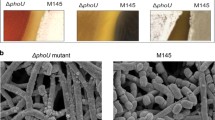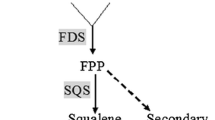Abstract
Transcription of the PHO84 gene encoding a Pi transporter in Saccharomyces cerevisiae is regulated by the Pi concentration in the medium. The promoter region of PHO84 bears five copies of the motif 5′-CACGT(G/T)-3′, a candidate for the upstream activation site (UAS) that binds the transcriptional activator protein of the phosphatase regulon, Pho4p. These motifs are found at nucleotides - 880 (site A), —587 (B), - 436 (C), - 414 (D), and - 262 (E) relative to the putative ATG codon of PHO84. The Pho4p protein binds to all five 6-bp motifs with various affinities. Deletion analysis of the PHO84 promoter using a PHO84-lacZ fusion gene and base substitutions in the 6-bp motif revealed that two copies of the 6-bp motif, either C or D, and E, are necessary and sufficient for full regulation of the PHO84 gene. Results of expression studies with a CYC1-lacZ fusion gene with various 36-bp oligonucleotides including the 30-bp sequences around site D or E, or with modified sequences, inserted in the CYC1 promoter region indicated that the 6-bp motif flanked by a thymine nucleotide at its 5′ end is much less effective as a UAS site for Pho4p in vivo than other versions. Thus, the consensus sequences for phosphatase regulation are 5′-GCACGTGGG-3′ and 5′-GCACGTTTT-3′ which differ from the binding sequences for the Cpflp protein required for transcription of the genes in methionine biosynthesis and for centromere function. However, Pho4p binding in vitro was unaffected by modification of the 5′ or 3' flanking sites of the 6-bp motif, while modification inside the 6-bp motif affected it severely. The UAS function of the GCACGTTTT motif with respect to the Pi signal depends on its orientation in the promoter sequence.
Similar content being viewed by others
References
Arima K, Oshima T, Kubota I, Nakamura N, Mizunaga T, Toh-e A (1983) The nucleotide sequence of the yeast PHO5 gene: a putative precursor of repressible acid phosphatase contains a signal peptide. Nucleic Acids Res 11:1657–1672
Bajwa W, Meyhack B, Rudolph H, Schweingruber A-M, Hinnen A (1984) Structural analysis of the two tandemly repeated acid phosphatase genes in yeast. Nucleic Acids Res 12:7721–7739
Baker RE, Masison DC (1990) Isolation of the gene encoding the Saccharomyces cerevisiae centromere-binding protein CP1. Mol Cell Biol 10:2458–2467
Barbarić S, Fascher KD, Hörz W (1992) Activation of the weakly regulated PHO8 promoter in S. cerevisiae: chromatin transition and binding sites for the positive regulatory protein PH04. Nucleic Acids Res 20:1031–1038
Blackwell TK, Weintraub H (1990) Differences and similarities in DNA- binding preferences of MyoD and E2A protein complexes revealed by binding site selection. Science 250:1104–1110
Bram RJ, Kornberg RD (1987) Isolation of a Saccharomyces cerevisiae centromere DNA-binding protein, its human homology, and its possible role as a transcription factor. Mol Cell Biol 7:403–409
Bun-ya M, Nishimura M, Harashima S, Oshima Y (1991) The PHO84 gene of Saccharomyces cerevisiae encodes an inorganic phosphate transporter. Mol Cell Biol 11:3229–3238
Cai M, Davis RW (1990) Yeast centromere binding protein CBF1, of the helix-loop-helix protein family, is required for chromosome stability and methionine prototrophy. Cell 61:437–446
Fisher F, Goding CR (1992) Single amino acid substitutions alter helix-loop-helix protein specificity for bases flanking the core CANNTG motif. EMBO J 11:4103–4109
Guarente L, Ptashne M (1981) Fusion of Escherichia coli lacZ to the cytochrome c gene of Saccharomyces cerevisiae. Proc Natl Acad Sci USA 78:2199–2203
Hayashi N, Oshima Y (1991) Specific cis-acting sequence for PHO8 expression interacts with PHO4 protein, a positive regulatory factor, in Saccharomyces cerevisiae. Mol Cell Biol 11: 785–794
Higuchi R (1990) Recombinant PCR. In: Innis MA, Gelfand DH, Sninsky JJ, White TJ (eds) PCR protocols: a guide to methods and applications. Academic Press, San Diego, Calif., pp 177–183
Hinnen A, Bajwa W, Meyhack B, Rudolph H (1987) Molecular aspects of acid phosphatase synthesis in Saccharomyces cerevisiae. In: Torriani-Gorini A, Rothman FG, Silver S, Wright A, Yagil E (eds) Phosphate metabolism and cellular regulation in microorganisms. American Society for Microbiology, Washington DC, pp 56–62
Hoshizaki DK, Hill JE, Henry SA (1990) The Saccharomyces cerevisiae INO4 gene encodes a small, highly basic protein required for derepression of phospholipid biosynthetic enzymes. J Biol Chem 265:4736–4745
Johnston M, Carlson M (1992) Regulation of carbon and phosphate utilization. In: Jones EW, Pringle JR, Broach JR (eds) The molecular and cellular biology of the yeast Saccharomyces: gene expression. Cold Spring Harbor Laboratory Press, Cold Spring Harbor, New York, pp193–281
Kaffman A, Herskowitz I, Tjian R, O'Shea EK (1994) Phosphorylation of the transcription factor PHO4 by a cyclin-CDK complex, PHO80-PHO85. Science 263:1153–1156
Kaneko Y, Toh-e A, Oshima Y (1982) Identification of the genetic locus for the structural gene and a new regulatory gene for the synthesis of repressible alkaline phosphatase in Saccharomyces cerevisiae. Mol Cell Biol 2:127–137
Kaneko Y, Hayashi N, Toh-e A, Banno I, Oshima Y (1987) Structural characteristics of the PHO8 gene encoding repressible alkaline phosphatase in Saccharomyces cerevisiae. Gene 58:137–148
Matsuzaki H, Nakajima R, Nishiyama J, Araki H, Oshima Y (1990) Chromosome engineering in Saccharomyces cerevisiae by using a site-specific recombination system of a yeast plasmid. J Bacteriol 172:610–618
Mellor J, Jiang W, Funk M, Rathjen J, Barnes CA, Hinz T, Hegemann JH, Philippsen P (1990) CPF1, a yeast protein which functions in centromeres and promoters. EMBO J 9:4017–4026
Nikoloff DM, McGraw P, Henry S (1992) The INO2 gene of Saccharomyces cerevisiae encodes a helix-loop-helix protein that is required for activation of phospholipid synthesis. Nucleic Acids Res 20:3253
O'Connell KF, Baker RE (1992) Possible cross-regulation of phosphate and sulfate metabolism in Saccharomyces cerevisiae. Genetics 132:63–73
O'Connell KF, Surdin-Kerjan Y, Baker RE (1995) Role of the Saccharomyces cerevisiae general regulatory factor CP1 in methionine biosynthetic gene transcription. Mol Cell Biol 15:1879–1888
Ogawa N, Oshima Y (1990) Functional domains of a positive regulatory protein, PHO4, for transcriptional control of the phosphatase regulon in Saccharomyces cerevisiae. Mol Cell Biol 10:2224–2236
Ogawa N, Noguchi K, Yamashita Y, Yasuhara T, Hayashi N, Yoshida K, Oshima Y (1993) Promoter analysis of the PHO81 gene encoding a 134-kDa protein bearing ankyrin repeats in the phosphatase regulon of Saccharomyces cerevisiae. Mol Gen Genet 238:444–454
Ogawa N, Hayashi N, Saito H, Noguchi K, Yamashita Y, Oshima Y (1994) Regulatory circuit for phosphatase genes in Saccharomyces cerevisiae: specific cis-acting sites in PHO promoters for binding the positive regulator Pho4p. In: Torriani-Gorini A, Silver S, Yagil E (eds) Phosphate in microorganisms: cellular and molecular biology. American Society for Microbiology, Washington DC, pp 56–62
Ogawa N, Noguchi K, Sawai H, Yamashita Y, Yompakdee C, Oshima Y (1995) Functional domains of Pho81p, an inhibitor of the Pho85p protein kinase, in the transduction pathway for Pi signals in Saccharomyces cerevisiae. Mol Cell Biol 15:997–1004
Oshima Y (1982) Regulatory circuits for gene expression: the metabolism of galactose and of phosphate. In: Strathern JN, Jones EW, Broach JR (eds) The molecular biology of the yeast Saccharomyces: metabolism and gene expression. Cold Spring Harbor Laboratory Press, Cold Spring Harbor, New York, pp 159–180
Parent SA, Fenimore CM, Bostian K (1985) Vector systems for the expression, analysis and cloning of DNA sequences in S. cerevisiae. Yeast 1:83–138
Parent SA, Justice MC, Yuan L-W, Hopper JE, Bostian KA (1994) Protein-DNA and protein-protein interactions regulating the phosphatase multigene family of Saccharomyces cerevisiae. In: Torriani-Gorini A, Silver S, Yagil E (eds) Phosphate in microorganisms: cellular and molecular biology. American Society for Microbiology, Washington DC, pp 63–69
Rose MD, Winston F, Hieter P (1990) Methods in yeast genetics: a laboratory course manual. Cold Spring Harbor Laboratory Press, Cold Spring Harbor, New York
Rudolph H, Hinnen A (1987) The yeast PHO5 promoter: phosphatecontrol elements and sequences mediating mRNA start-site selection. Proc Natl Acad Sci USA 84:1340–1344
Sambrook J, Fritsch EF, Maniatis T (1989) Molecular cloning: a laboratory manual. 2nd ed. Cold Spring Harbor Laboratory Press, Cold Spring Harbor, New York
Sapira SK, Chou J, Richaud FV, Casadaban MJ (1983) New versatile plasmid vectors for expression of hybrid proteins coded by a cloned gene fused to lacZ gene sequences encoding an enzymatically active carboxy-terminal portion of β-galactosidase. Gene 25:71–82
Schneider KR, Smith RL, O'Shea EK (1994) Phosphate-regulated inactivation of the kinase PHO80-PHO85 by the CDK inhibitor PHO81. Science 266:122–126
Sengstag C, Hinnen A (1988) A 28-bp segment of the Saccharomyces cerevisiae PHO5 upstream activator sequence confers phosphate control to the CYC1-lacZ gene fusion. Gene 67:223–228
Toh-e A, Nakamura H, Oshima Y (1976) A gene controlling the synthesis of non specific alkaline phosphatase in Saccharomyces cerevisiae. Biochim Biophys Acta 428:182–192
Toh-e A, Oshima Y (1974) Characterization of a dominant, constitutive mutation, PHOO, for the repressible acid phosphatase synthesis in Saccharomyces cerevisiae. J Bacteriol 120:608–617
Vogel K, Hörz W, Hinnen A (1989) The two positively acting regulatory proteins PHO2 and PHO4 physically interact with PHO5 upstream activation regions. Mol Cell Biol 9:2050–2057
Yanisch-Perron C, Vieira J, Messing J (1985) Improved M13 phage cloning vectors and host strains: nucleotide sequences of the M13mp18 and pUC19 vectors. Gene 33:103–119
Yoshida K, Kuromitsu Z, Ogawa N, Oshima Y (1989a) Mode of expression of the positive regulatory genes PHO2 and PHO4 of the phosphatase regulon in Saccharomyces cerevisiae. Mol Gen Genet 217:31–39
Yoshida K, Ogawa N, Oshima Y (1989b) Function of the PHO regulatory genes for repressible acid phosphatase synthesis in Saccharomyces cerevisiae. Mol Gen Genet 217:40–46
Author information
Authors and Affiliations
Additional information
Communicated by C. P. Hollenberg
Rights and permissions
About this article
Cite this article
Ogawa, N., Saitoh, H., Miura, K. et al. Structure and distribution of specific cis-elements for transcriptional regulation of PH084 in Saccharomyces cerevisiae . Molec. Gen. Genet. 249, 406–416 (1995). https://doi.org/10.1007/BF00287102
Received:
Accepted:
Issue Date:
DOI: https://doi.org/10.1007/BF00287102




